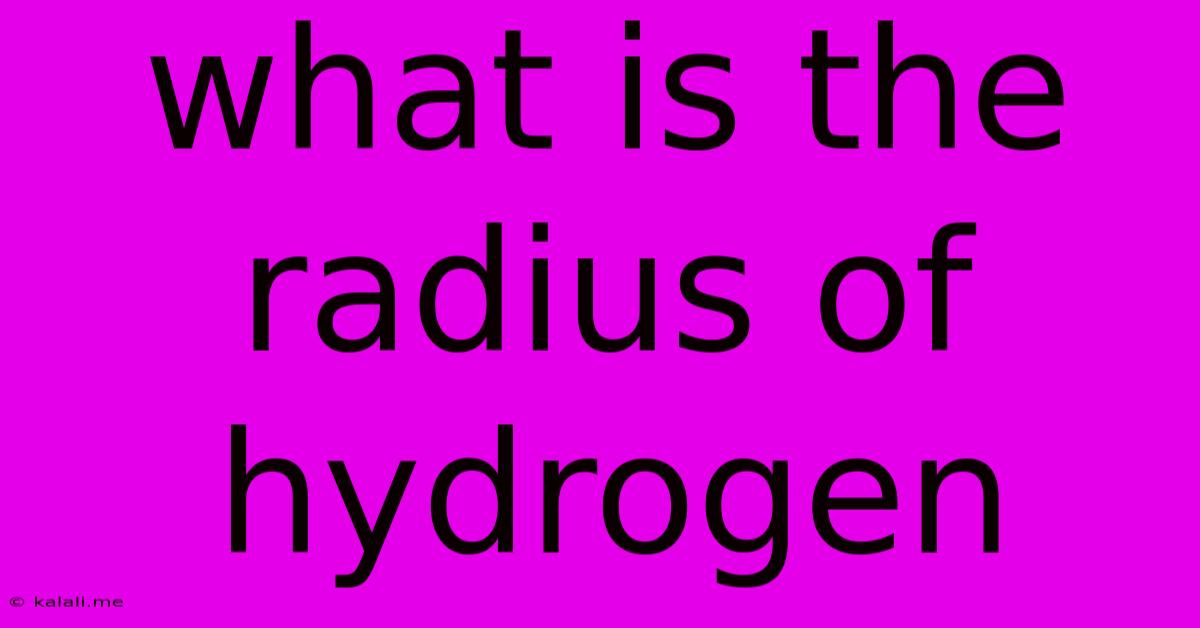What Is The Radius Of Hydrogen
Kalali
Jun 14, 2025 · 3 min read

Table of Contents
What is the Radius of Hydrogen? Understanding Atomic Size and its Challenges
Determining the precise radius of a hydrogen atom is surprisingly complex, and doesn't lend itself to a single, simple answer. Unlike measuring the radius of a macroscopic sphere, atoms don't have a clearly defined edge. Their electron cloud gradually fades out with increasing distance from the nucleus. This means the "radius" is a concept that depends on how we choose to define it. This article explores different ways to define and measure the hydrogen atom's size and explains the difficulties involved.
Understanding Atomic Structure: Why it's Complicated
The hydrogen atom, the simplest atom, consists of a single proton in the nucleus and a single electron orbiting it. However, this orbiting electron doesn't follow a neat, predictable path like a planet around a star. Instead, it exists in a probabilistic cloud, described by its wave function. This means we can only talk about the probability of finding the electron at a particular distance from the nucleus.
Different Definitions of Atomic Radius:
Several methods are used to define and measure atomic radius, each leading to slightly different results. These include:
-
Bohr Radius (a₀): This is perhaps the most commonly cited radius for hydrogen. It's based on the Bohr model, a simplified model of the atom, and represents the most probable distance of the electron from the nucleus in the ground state (lowest energy level). The Bohr radius is approximately 0.529 Å (angstroms), or 52.9 pm (picometers). It's important to note that this is just a simplified approximation.
-
Van der Waals Radius: This measures the effective size of an atom when it's interacting with other atoms through weak van der Waals forces. The van der Waals radius of hydrogen is significantly larger than the Bohr radius, reflecting the extent of the electron cloud when influenced by neighboring atoms.
-
Covalent Radius: This refers to half the distance between the nuclei of two hydrogen atoms when they are bonded together covalently. This value also differs from the Bohr radius due to the electron sharing between the atoms.
Why the Differences Matter:
The variation in the reported radius of hydrogen depending on the chosen definition highlights the limitations of simplistic models. The Bohr radius provides a useful starting point for understanding atomic structure, but it doesn't accurately represent the atom's size in all contexts. The van der Waals and covalent radii offer more realistic approximations of the atom's size in specific interactions.
Factors Affecting Atomic Size:
Several factors beyond the model used can influence how we measure the effective size of the hydrogen atom. These include:
- Energy Level: The electron can exist in different energy levels, and its average distance from the nucleus will vary depending on the energy level. Higher energy levels correspond to larger average distances.
- Interactions with other atoms or molecules: When hydrogen is part of a molecule or interacts with other atoms, its electron cloud is influenced, leading to variations in its apparent size.
- Temperature and Pressure: These macroscopic factors can influence the average distance between hydrogen atoms, thereby affecting measurements of its effective size.
Conclusion:
There isn't a single definitive answer to the question "What is the radius of hydrogen?" The answer depends heavily on how you define "radius" and the context in which you're considering the atom's size. The Bohr radius (approximately 0.529 Å) provides a useful, albeit simplistic, approximation, but more realistic measures, like the van der Waals and covalent radii, are more appropriate for many real-world scenarios. Understanding these different definitions and their limitations is key to a thorough comprehension of atomic structure and size.
Latest Posts
Latest Posts
-
4 Is Subtracted From The Cube Of A Number
Jun 15, 2025
-
What Are A Group Of Stars Called
Jun 15, 2025
-
Which Of The Following Devices Measures Air Pressure
Jun 15, 2025
-
What Is The Difference Between Glycogen And Starch
Jun 15, 2025
-
T20 World Cup 2030 Host Country
Jun 15, 2025
Related Post
Thank you for visiting our website which covers about What Is The Radius Of Hydrogen . We hope the information provided has been useful to you. Feel free to contact us if you have any questions or need further assistance. See you next time and don't miss to bookmark.